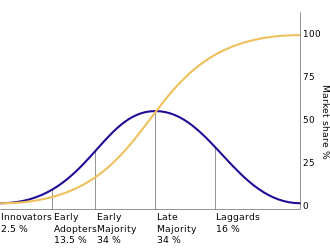Facebook: Diffusion of Innovation
The Rogers Diffusion of Innovations is a theory that explains how, why, and what rate new technologies spread. Evert Rogers, who was an American communication theorist and sociologist, introduced this theory in his book Diffusion of Innovations. As seen below, the categories of adopters are innovators, early adopters, early majority, late majority, and laggards. The innovators seek change, the early adopters use technology as soon as it's available, the early majority uses technologies when they see the success of technology, the late majority refers to people who only adopt a new product until the majority of people already has, and finally laggards refers to traditionalist who are last to adopt a new technology.

A well known social media app, known as Facebook, had a large impact on society in that it was one of the firsts of it's kind. Facebook was founded by Mark Zuckerberg in February of 2004 and ever since has been rising in regards to the Diffusion of Innovation chart. The early adopters of facebook include a small percentage of the baby boomers generation. Since the generation of the millennials did not reach the age cut off of facebook when it first came out, they became the early majority of users. The late majority refers to the rest of the baby boomers generation that are now seeing the success of facebook through other users. Lastly, the laggard consist of those that are traditionalists such as our (millennials) grandparents. The millennials help set up these facebook pages for their grandparents to stay connected to friends and family. Facebook spread fairly fast throughout many generations and is still making it way into newer generations.

Comments
Post a Comment